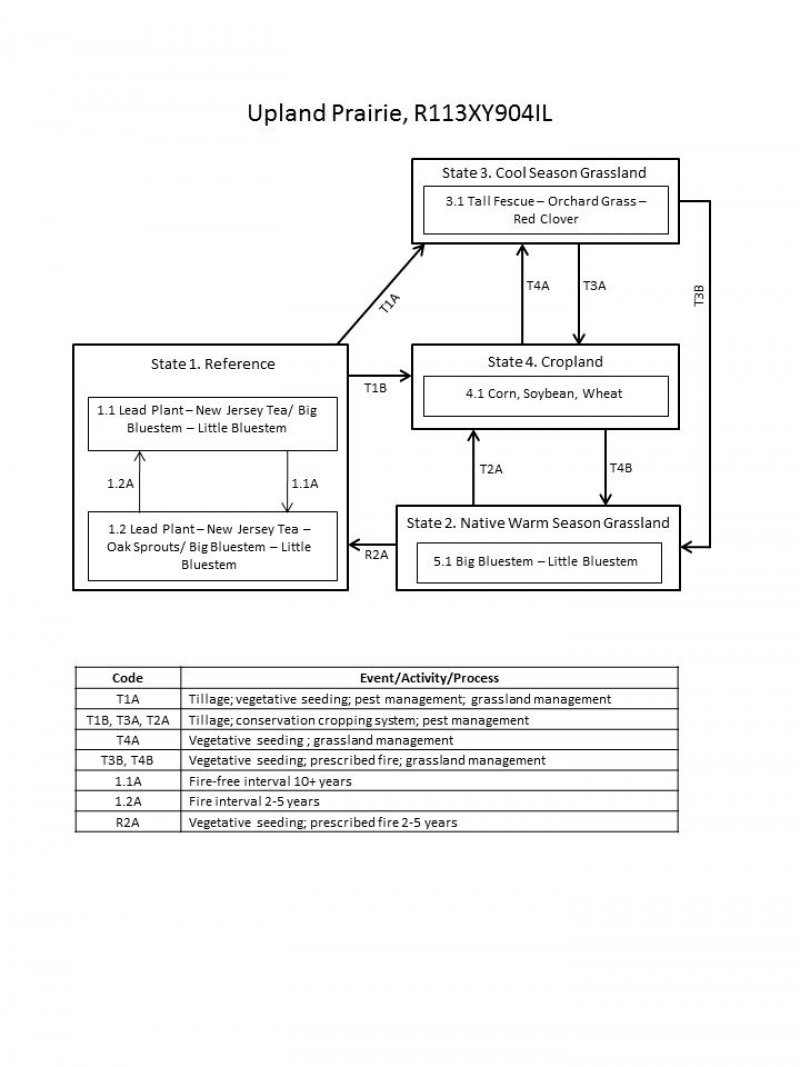
Natural Resources
Conservation Service
Ecological site R113XY904IL
Upland Prairie
Last updated: 5/17/2024
Accessed: 12/22/2025
General information
Provisional. A provisional ecological site description has undergone quality control and quality assurance review. It contains a working state and transition model and enough information to identify the ecological site.
MLRA notes
Major Land Resource Area (MLRA): 113X–Central Claypan Areas
The eastern Illinois portion of the Central Claypan Areas MLRA is in the Till Plains Section of the Central Lowland Province of the Interior Plains (USDA-NRCS, 2006) and includes the Southern Till Plain Natural Division of the natural divisions of Illinois (Schwegman, 1973; 1997; IDNR, 2018) in south-central Illinois. South-central Illinois is a dissected Illinoisan till plain south of the terminal Wisconsin moraine. This region consists of nearly level to gently sloping, old till plains. Stream valleys are shallow and generally are narrow. Elevation is about 660 feet (200 meters), increasing gradually from south to north. Local relief is generally low on the broad, flat till plains and flood plains and high on the dissected hills bordering rivers or drainage systems. The Kaskaskia, Little Muddy, Little Wabash, Embarras, and Skillet Fork rivers are part of this area. This region is covered with loess, which overlies old glacial drift (Illinoisan till) that has a high content of clay. Fragipans are also present. Pennsylvanian limestone and shale bedrock underlay the glacial till. The dominant soil orders in this region are Alfisol and Mollisol. The soils in the area predominantly have a mesic soil temperature regime, an aquic or udic soil moisture regime, and mixed or smectitic mineralogy. They generally are very deep, well drained to poorly drained, and loamy or clayey. (USDA-NRCS, 2006).
Classification relationships
Major Land Resource Area (MLRA) (USDA-NRCS, 2006):
113 – Central Claypan Areas, Eastern Part
U.S. Forest Service Ecoregions (Cleland et al. 2007):
Domain: Humid Temperate Domain
Division: Hot Continental Division
Province: Eastern Broadleaf Forest (Continental)
Province Code: 222
Section: Central Till Plains, Oak-Hickory Section
Section Code: 222G
Ecological site concept
The historic reference plant community was a mesic tall grass prairie with a tree canopy of less than 10 percent. There is a single layer of dominant graminoids intermixed with abundant forbs and occasional scattered shrubs and trees (NatureServe 2018).
Big bluestem (Andropogon gerardii Vitman)* was the dominant grass on Upland Prairies. Other common grasses included little bluestem (Schizachyrium scoparium (Michx.) Nash), and Indiangrass (Sorghastrum nutans (L.) Nash) (NatureServe 2018). Forbs typical of an undisturbed plant community associated with this ecological site included candle anemone (Anemone cylindrica A. Gray), downy gentian (Gentiana puberulenta J. Pringle), stiff sunflower (Helianthus rigidus Nutt. ssp. pauciflorus), tall cinquefoil (Potentilla arguta Pursh), pinnate prairie coneflower (Ratibida pinnata (Vent.) Barnhart) and prairie violet (Viola pedatifida G. Don) (White 1978; NatureServe 2015). Shrubs, such as silky dogwood (Cornus obliqua Raf.) and white meadowsweet (Spiraea alba Du Roi), were present but not overly abundant (Mohlenbrock and Ladd, 1978; Mohlenbrock, 1986). On lower slopes and draws where water periodically accumulated, more mesic prairie species such as switchgrass (Panicum virgatum L.), eastern gamagrass (Tripsacum dactyloides (L.) L.), Culver’s root (Veronicastrum virginicum (L.) Farw.), Michigan lily (Lilium michiganense Farw.), and Virginia bunchflower (Veratrum virginicum (L.) W.T. Aiton) may have been added to the diverse mix of prairie species (White 1978).
Shrubs, when present, were generally low-growing and sparse and included leadplant (Amorpha canescens Pursh), New Jersey tea (Ceanothus americanus L.), and Carolina rose (Rosa carolina L.). Occasional fire-tolerant oaks (Quercus spp.) were also scattered throughout the landscape. Fire is the primary disturbance factor that maintains this site, while herbivory and drought are secondary factors (LANDFIRE 2009; White 1978; NatureServe 2018).
* All plant common and scientific names in this document were obtained from the U.S. Department of Agriculture – Natural Resources Conservation Service National PLANTS Database (USDA NRCS, 2018).
Associated sites
| R113XY902IL |
Natric Till Plain Savanna Found on similar landscape positions but soil profile has high sodium levels that impact species composition. |
|---|---|
| R113XY903IL |
Wet Upland Prairie Found on similar landscape positions but with poorer drainage and higher seasonal water tables. |
| F113XY919IL |
Wet Silty Floodplain Forest Found in drainageways and floodplains below Upland Prairies. |
Similar sites
| R113XY903IL |
Wet Upland Prairie Found on similar landscape positions but with poorer drainage and higher seasonal water tables. |
|---|
Table 1. Dominant plant species
| Tree |
Not specified |
|---|---|
| Shrub |
(1) Amorpha canescens |
| Herbaceous |
(1) Andropogon gerardii |
Click on box and path labels to scroll to the respective text.
| T1A | - | Tillage; vegetative seeding; pest management; grassland management |
|---|---|---|
| T1B | - | Tillage; conservation cropping system; pest management |
| R2A | - | Vegetative seeding; prescribed fire 2-5 years |
| T2A | - | Tillage; conservation cropping system; pest management |
| T3B | - | Vegetative seeding; prescribed fire; grassland management |
| T3A | - | Tillage; conservation cropping system; pest management |
| T4B | - | Vegetative seeding; prescribed fire; grassland management |
| T4A | - | Vegetative seeding ; grassland management |
State 1 submodel, plant communities
| 1.1A | - | Fire-free interval 10+ years |
|---|---|---|
| 1.2A | - | Fire interval 2-5 years |
